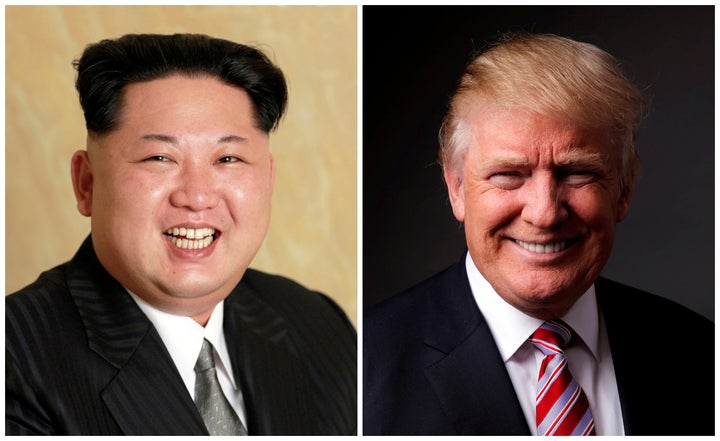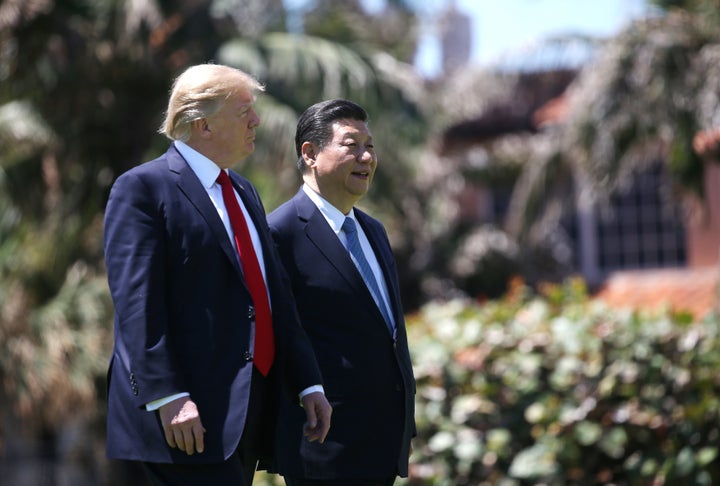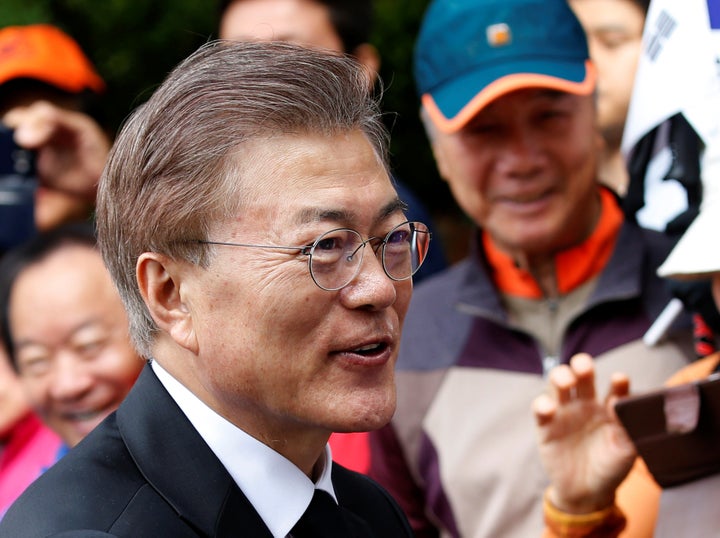
SEOUL, South Korea ― The escalating crisis on the Korean Peninsula is the result of two men of braggadocio engaged in a struggle for recognition. As these unpredictable heads of state, U.S. President Donald Trump and North Korean leader Kim Jong Un, face off, there is a potential for more chaos. But there is also an opportunity to turn the tables towards peace. How Trump plays his cards, with South Korea’s new president and the role of China in mind, will determine what happens next. If he hopes to de-escalate tensions, Trump will need to follow a careful roadmap, forming an open dialogue with Kim and pressuring Pyongyang to cease its development of nuclear weapons.
The situation in North Korea stretches back long before Donald Trump became president ― when Kim Jong Un inherited the nuclear ambitions of his father, Kim Jong Il. But the U.S. president’s aggressive manner and deal-making skills now present the world with a unique chance at what has long seemed out of reach. The fact that both Kim and Trump are determined to show the strength of their respective countries as they confront one another may end up alleviating rather than exacerbating this crisis.
At the age of 27, Kim Jong Un was bequeathed a country in tatters, both economically and socially, without an inkling of how to rule it. It is his reckless ambition to gain international recognition of his regime as a nuclear state. And he has made it clear during his reign that he believes that his country’s nuclear arms and missiles are the only deterrence to military attack by the United States. For Kim, nuclear weapons are key to the legitimacy of his family’s hereditary dictatorship ― and his means of maintaining control. At least until Donald Trump came into the picture.
“For Kim, nuclear weapons are key to the legitimacy of his family’s hereditary dictatorship ― and his means of maintaining control.”
Trump, a man who also does not like to lose or be slighted, was an unexpected rival. In Kim, the U.S. president saw the perfect opportunity to demonstrate to the world the power of a strong America and his own return to former U.S. President Ronald Reagan’s doctrine of “peace through strength,” the notion of preparing for conflict in order to achieve the ultimate opposite.
Since the early days of his presidential campaign, Trump has taken this path, making it known that he would not put up with nuclear provocations from North Korea. As president, his rhetoric on a pre-emptive or preventive strike on the North’s nuclear and missile facilities were his strongest message on the issue. And it seems to have shaken things. Contrary to expectations from experts, who feared the harsh tone by Trump would heighten already existing tensions, Kim Jong Un let April pass without a sixth nuclear test. The North Korean alpha dog appears to be responding to the threats of the American alpha dog. Indeed, Pyongyang has even recently floated the idea of possible bilateral talks between the two countries. But this does not mean the threat of another nuclear test is out of the question, as Sunday’s test showed.
I welcome Trump’s North Korea policy of maximum pressure and engagement. Deploying U.S. strategic weapons on the peninsula is a necessary move if we are to restrain Kim’s provocative actions. Such a move, embraced by South Korea, must also be further complemented with strong international sanctions.

But pushing back against the regime as it tests ballistic missiles is not the only thing Trump should do. His current strategy has worked well to maintain a balance between the two nations, but to achieve long-term denuclearization, he needs to go farther ― and he needs nuance.
In this respect, President Trump is on the right track. His remarks about Kim being a “smart cookie” and his assertions that he would be willing to meet with the North Korean leader will be what helps him to keep the possibility of engagement open and eventually lead to dialogue where other U.S. leaders have failed. But it won’t be easy.
The Immediate Victim Could Be South Korea
Before we can see a Kim-Trump summit, there are critical challenges that must be met to ensure the crisis does not reach untenable heights. It is not a foregone conclusion that Kim would definitely give up his nuclear program, now in its “final stage” of development, to meet with Trump. If he doesn’t, South Korea will bear the brunt.
Time is running out for my country. If, as many experts project, North Korea comes to possess some 20 to 50 nuclear warheads by 2020, the denuclearization of North Korea may not be possible for the next few decades, or within the 21st century, unless the Kim regime collapses. It is imperative then that the U.S. takes measures to halt the North’s development of ballistic missiles before Pyongyang comes to possess intercontinental ballistic missiles, or ICBMs, with the capacity to hit America. Such a development by the North, would only mean retaliation by America and the potential for war in the region, something that would hurt the stability of South Korea.
“Time is running out for my country.”
South Korea must prevent a war at any cost. Many South Koreans would rather have a bad peace than an ultimately good war. So Trump needs to tread carefully. A dramatic action such as a U.S. pre-emptive strike on North Korean nuclear facilities would no doubt bring about a retaliatory attack by the North on U.S. military bases in South Korea and Japan, which would lead at the least to a limited war — or in a worst case scenario, a second Korean War on the peninsula. This is why most Koreans are unequivocally in agreement about a more measured response to North Korea. We need to check the military provocations of the North, but we cannot retaliate in kind or with such aggression so as to provoke an all-out war. The election of Moon Jae-in – who favors dialogue with the North ― as our new president last week is a strong indication of the nation’s desire for a peaceful path forward.
Trump’s Next Move: Establish Roadmap With Beijing & Seoul
In his own short term in office so far, the U.S. president has achieved progress on North Korea. His summit with Chinese President Xi Jinping at his Mar-a-Lago resort in Florida, secured a promise from Beijing to cooperate with the international community to denuclearize the North, including the possible cutoff of its oil supplies. But China could do more. Trump will need to pressure Xi to create a visible impact in his country’s policy toward the North. And he’ll need to continue to take more steps to de-escalate the current crisis, working with China and South Korea to develop a roadmap to peace on the Korean Peninsula that can ultimately be presented to North Korea.

This proposed roadmap could be divided into two stages:
1. Stop North Korea’s development of nuclear arms and missiles at the current level.
The nuclear halt must be transparent, fully inspected and approved by the international community. Should the United States open up relations with the North while the regime continues to possess some reported 20 or more nuclear warheads, then the South Korean people will have to carry this burden of having a dangerous nuclear state in their backyard for the rest of their lives, not knowing when, or if, true denuclearization will ever be realized. The Trump administration will thus need to keep in mind such concerns of the South and reaffirm the extent of its deterrence toward the North, including its provision of a nuclear umbrella in the region.
To reach this agreement on nuclear stoppage by North Korea, the U.S. will have to win the North’s trust by promising not to pursue regime change and assuring it of a policy of non-aggression.
2. Start a dialogue or negotiation with North Korea.
At this stage, the United States must share the details and strategies of its negotiation with the South, so that no isolation of the South in the negotiation process occurs. As the U.S.-North Korea dialogue begins, the South must also pursue a dialogue with the North as the second pillar of the roadmap toward peace. At the last phase of the second stage negotiations, it is imperative that North Korea give assurance of its intention to renounce all nuclear and ballistic missile programs in a trustworthy, and particularly verifiable, manner.
“Participation of South Korea, China, Japan and Russia in this peace roadmap is essential to counter the North’s perceived American threat to the regime’s security.”
Once the dialogues between the U.S. and the two Koreas reach a more stable point, then the engagements must be synchronized, and China must be invited to take part to reach a peace treaty. Such a peace treaty should be endorsed by the other two regional powers, Russia and Japan. Participation of the four powers around the Korean Peninsula is essential to take care of the North’s perceived American threat to the regime’s security.
In order to get to such a point, especially because both Kim Jong Un and Donald Trump are men of unexpected actions, the United States and North Korea cannot afford to miscalculate each other’s intentions. If Pyongyang conducts more nuclear and missile tests and Washington pushes the pre-emptive strike button, no one can tell what will happen.
It is at such a moment that I would like implore President Trump to pursue a Korea policy that is coherent and wholeheartedly serious. Throwing out ideas that are a matter of life or death to South Korea, is like saying South Korea should pay for the cost of the U.S.-funded Terminal High Altitude Area Defense, or THAAD missile defense system, now deployed in my country as part of our alliance. Such an approach needlessly sows confusion and only boosts Kim’s confidence. The United States will have to maintain a balance in throwing carrots and sticks at the North if it is to achieve the roadmap outlined here. But with Trump, there is hope.

The man in the Oval Office is a skilled deal-maker with the sharp insight of a businessman. Compared to his predecessor, former U.S. President Barack Obama, he takes an aggressive stance on the issues presented before him. This is his strength. Donald Trump may be the U.S. president who can turn the tables in the region to transform troubles and threats into opportunity and bring us closer to resolving the North Korean issue. But this will only be possible if he stops to think and channel his aggression into a concrete plan such as the one I have suggested.
For now, as far as security on the peninsula is concerned, Moon Jae-in, the new South Korean president, has taken over what a former CIA chief-of-staff called a “tinder box” of a fragile situation. But fortunately, the progressive president is no less committed to pursuing peace through talks than Trump is seriously preoccupied with deterring North Korea’s nuclear and missile programs ― the root cause of the whole crisis.
The South Korea-U.S. alliance is solid enough to handle this tense situation. And the two presidents will make an ideal duo in tackling it. So I look forward to seeing a bold, creative and coherent strategy from President Trump, and I hope he can work with newly elected President Moon and President Xi to ultimately achieve peace in the Korean Peninsula.

